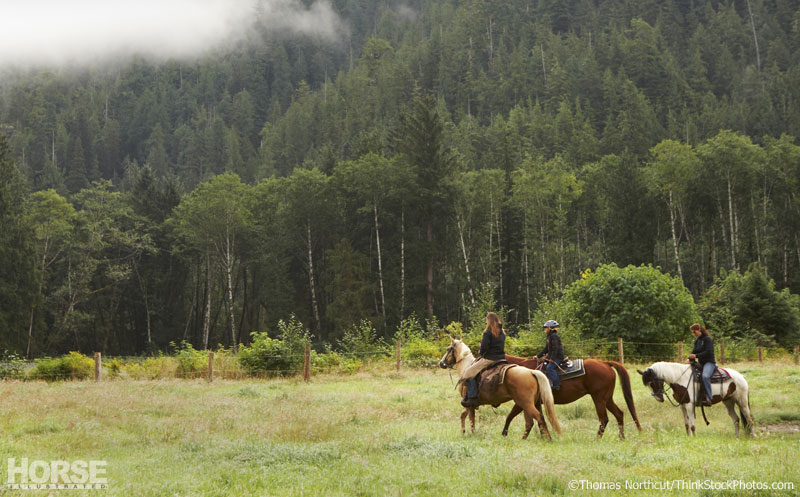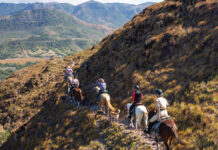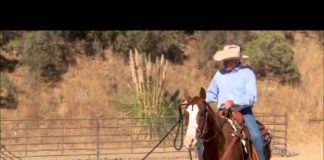
American Competitive Trail Horse Ride by Bureau of Land Management Oregon and Washington via flickr/CC BY 2.0
The trail is washed out and impassable. Your friend’s horse is showing signs of heat stress. You have a sneaking suspicion that you are lost. It’s getting dark and your feet are killing you. These are some of the many predicaments that trail riders seem to get themselves into.
Wardrobe Malfunctions
You’re several hours into a ride and your feet are throbbing. You realize that it was a mistake to ride in a brand-new pair of boots. Your new jeans are making you wish you’d bought a roomier pair. What’s worse is you still have two hours of riding left. You’re so desperately uncomfortable that you would do almost anything to get out of the offending articles of clothing. What are your options?
Dismount and walk for a little while. You can also adjust the length of your stirrups to relieve the pressure on your feet, and some of the restriction of your tight new jeans.
You want to be adequately protected in both hot and cold weather, so choose your clothing carefully. Dress in layers that you can shed if necessary. Wear comfortable shoes that you have already broken in, with heels that are designed for riding so your feet won’t slip through the stirrups. Stories of riders who are critically—even fatally—injured as a result of getting a foot caught in a stirrup are all too common. You certainly don’t want to be one of the statistics. The same goes for riding helmets. The body heals; the brain doesn’t.
Loose Horse
Your group decides to take a break under the shade of a large tree. You tie your horse to a branch and start to walk away, but your horse suddenly pulls back, breaking the branch with a loud crack. You jump forward to catch him, but it’s too late. Your horse bolts and disappears into the woods, dragging the branch with him. What should you do?
Begin the search for the horse immediately, but don’t chase a runaway horse—he will only keep running. Start with a plan. Determine how much time you have to search, taking into consideration the amount of daylight remaining and how far you are from your original starting point. There’s no sense in getting the whole group lost while looking for one horse. Make everyone aware of the direction you intend to search in and how long you will look before returning. Try to follow the horse’s tracks, if possible. If you don’t find him, then notify the appropriate land management agency, area ranchers and the local horseman’s association because they may be willing to help. The faster you are able to mobilize a search party, the greater the chances that you will find your horse.
The biggest fears associated with losing a horse are not knowing where to search and worrying about the horse getting his tack hung up on something. Stories abound of horses being found days, weeks, even months later without a mark on them, so don’t give up.
The Speed of Dark
You’re out for an afternoon trail ride when you discover a new trail and decide to explore it. Although your common sense tells you that it’s getting late and you should head back, you press on. When you finally do resign to turning around, you realize that you have gone a lot farther than you intended, and the sun is setting quickly. What should you do?
Trail riders are notorious for overestimating how much ground they can cover before the sun goes down. Don’t take shortcuts unless you are absolutely certain where you’re headed. Don’t forsake safety for speed, either. It would be unwise to gallop your horse across rocky terrain to get back before dark. You only run the risk of injuring your horse or yourself.
If it gets dark, don’t panic. Horses have excellent night vision, especially if there is some ambient light from the moon and stars. Once horses’ eyes adjust to darkness, they are able to maneuver just as well as they do during the day.
Attitude Adjustment
You are riding in a group and one of the horses continues to threaten the others by pinning his ears and wringing his tail. It’s clear that he may try to kick another horse. What’s the solution?
One of the attributes of a good trail horse is behaving around others when riding in a group. He should accept riding ahead of, behind and beside other horses. He should also pass other horses and accept being passed by others without exhibiting any intimidating behavior. Horses that threaten to kick or bite should be relegated to the back of the group. Then it’s his rider’s responsibility to maintain a safe distance from everyone else.

The Point of No Return
You are riding along a narrow, single-track trail when you encounter a section that has been washed out, and there is no way around. Your only option is to go back the way you came, but there is no place to turn around. There is a steep hill on one side of you and a drop-off on the other side. What do you do?
Dismount on the high side of the trail and ask your horse to carefully back up until you get to a spot that is wide enough to change direction and remount.
Too Hot to Handle
It is unusually hot and humid, and your horse appears to be suffering from the heat—he is sweating heavily and panting. What should you do?
Subjecting a horse to high temperatures, particularly if combined with high humidity, can be life-threatening. If a horse’s core temperature reaches critical levels (more than several degrees above normal) and there is no means available to cool him down, the result can be fatal. If your horse’s pulse is high (greater than 72 beats per minute), if he is panting, or if his pulse and respiration rates are inverted (respiration is higher than pulse), he is overworking and possibly overheating. Ideally, you want to get him to the nearest water source and douse his neck, sides and legs with water. Remove your saddle to help cool him down faster. Continue to soak him until his heart rate and respiration return to normal. If no water is available, get your horse into the shade and remove your saddle.
Lost
You’ve been riding for several hours in a remote area and realize that you must have missed a turn somewhere. The trail you are on is beginning to disappear, and you have a strong sense that you are riding in the wrong direction. What should you do?
If you have a trail map, try to identify the trail you are on. If you can’t, retrace your steps to the last trail marker or sign you encountered and continue to retrace your steps until you can confidently identify your location. Don’t continue down an unfamiliar trail—especially if it is evident that it doesn’t see much traffic—to “see where it goes.” If you find a “new” trail that appears to have had little traffic, it’s best to research it first (via Google Earth maps or the United States Forest Service). You should never venture past a point that you can’t return from.
Shoeless
Your horse loses a shoe during your trail ride. What should you do?
If you carry a protective hoof boot in your saddle pack, put it on your horse’s bare hoof and continue your ride. If you don’t have one of these boots and no one else in your group has one they can loan you, then you are in for a long walk back. You shouldn’t continue riding, as you can do serious damage to your horse’s bare hoof. Choose the shortest, easiest way home or back to your trailer, and avoid walking on sharp rocks or gravel, if possible.
Sliding Saddle
As you ride down a steep trail, your saddle begins to slip forward. You look down to see that it is now well over your horse’s withers. What should you do?
Turn your horse sideways on the trail and dismount on the high side. Lead your horse down the rest of the trail on foot. It is dangerous to have your saddle slip forward while you are riding downhill, as it forces your weight forward, making it harder for your horse to balance his own weight on his hindquarters as he descends. If the saddle slips far enough forward, the girth will “grab” him behind the elbows, causing significant discomfort. You also run the risk of getting dumped if your horse decides he doesn’t like you and your saddle up around his neck. When you get to the bottom of the hill, readjust your saddle. If you encounter this problem on a regular basis, evaluate your saddle to make sure it fits properly. If the saddle slips forward because your horse is round-backed and has low, round withers, then consider using a crupper, which attaches to the back of the saddle and goes under the horse’s tail to keep the saddle in place. Your horse might need some training to adapt to this set-up.
Out of Bounds
You are riding along your usual route and come across a gate that is closed and marked with a sign that reads “trail closed.” What should you do?
Choose another route. There is likely a good reason why the trail has been closed, even if it’s not immediately apparent. Trespassing is against the law, and it’s a surefire way to have access permanently denied. You can contact the land’s manager to inquire why the trail has been closed and for how long.
Chills and Spills
A deer runs across the trail and startles some of the horses in your group. One horse bucks and throws his rider. What do you do?
First and foremost, make sure that the fallen rider is OK. If she has sustained any injuries, seek immediate medical assistance. Do not move her, even if she seems to be unharmed. If there are several riders in your group, send someone to call for help while at least one person stays with the injured rider. If someone has a cell phone with a GPS function, note the coordinates of your location. This will help rescue personnel locate you quickly.
Be Prepared
When it comes to trail riding, adequate preparation is the best defense against unforeseen circumstances. Always bring a first aid kit for horses and humans. Carry your cell phone in your pocket, not in your saddle pack, so you have it if you and your horse are separated. Study the trail maps if you are riding in unfamiliar territory and check the weather before you head out. Last but not least, listen to the voice in your head that is your common sense—like your horse, it rarely steers you wrong.
Jennifer Nice has logged more than 7,000 miles in endurance competition, including three Tevis Cup finishes and two Virginia City 100 wins.
This article originally appeared in the July 2009 issue of Horse Illustrated. Click here to subscribe.






great advice- I’m going to need this when I start endurance! I remember when I was with a friend and ewhat we thought was a trail turned into a dry stream bed. The horses were knee deep in mud and we were getting poked in the face with branches. Not a good situation!
Great advice. I have my name, cell number and horses name attached to my saddle. If she is found and someone can catch her, they will know who she belongs to. My son-in-law gave me a personal GPS. I set the coordinates when I leave the horse trailer and always find my way back.
Great advice!! I trail ride all the time and some of this stuff I didn’t know about so I’m glad this article was here for me to read. I suggest telling anyone who trail rides to read this first before they head out to hit the trails.